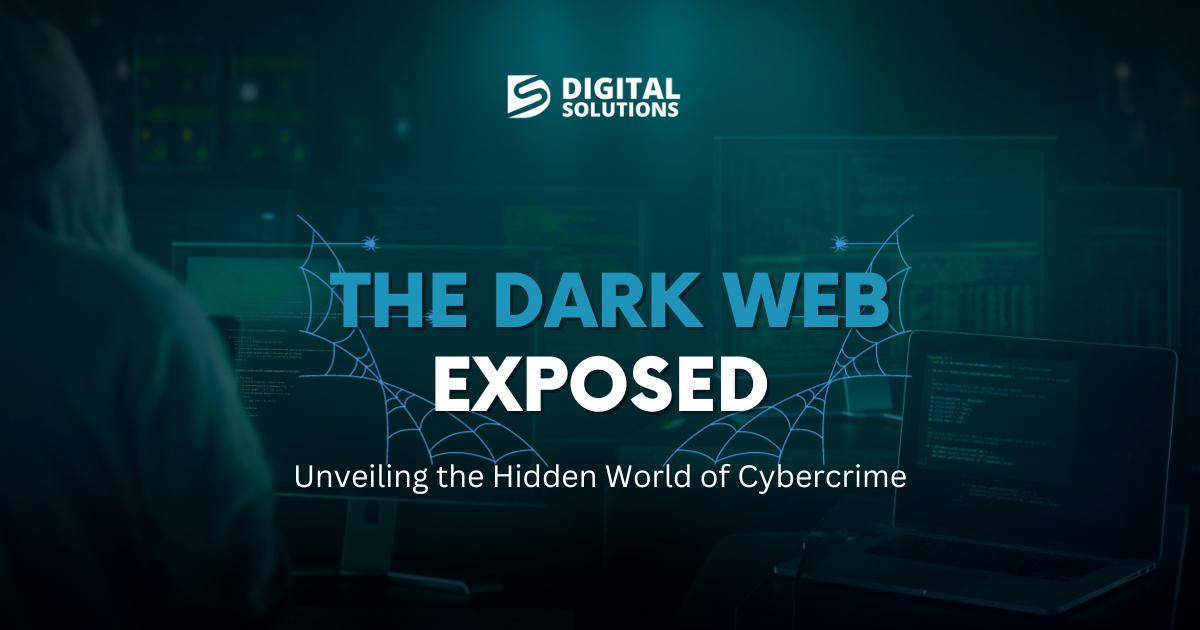- Oct 24, 2023
- Amir Farooq
- No Comments

The internet holds endless knowledge, connections, and opportunities. But beneath the surface lies the dark web – a hidden cybercrime world corner of the internet rife with illegal activities shrouded in anonymity. What really goes on in these virtual undergrounds? Turn on your encrypted connection as we unravel the concealed side of cybercrime lurking within the depths of the dark web.
Diving into the Shadows: An Introduction to the Dark Web
The dark web refers to networks and sites that exist privately on layers of encryption. Unlike the regular internet you surf everyday, the dark web is completely anonymous – users can’t be identified or traced. To access it, you need an encryption system like The Onion Router (Tor). This obscures who you are and where you go online. The dark web’s total anonymity enables everything from classified government leaks to coordinated criminal operations. That includes drug and weapons trafficking, identity theft rings, hacking groups, and disturbingly, child exploitation content.
While parts of the dark web facilitate free speech away from authoritarian eyes, large swathes serve as a haven for serious illegal activities. But how big is this hidden criminal underground? Estimates suggest the dark web makes up only about 0.1% of the entire internet, with most users seeking privacy or conducting research. However, the minority involved in illicit cybercrime still amounts to an extensive network of secretive wrongdoing.
Our dark web exploration takes us on an eye-opening voyage to confront the many faces of online criminal enterprise.
Hotbeds of Anarchy: Cybercrime on the Dark Web
For cybercriminals, the dark web provides the ideal cover for criminal coordination. The anonymity enables evasion of surveillance while connecting grassroots groups into sophisticated global networks. Participants can buy and sell illegal goods and services through dark web marketplaces and communities. Transactions occur anonymously in cryptocurrencies like Bitcoin. The scope of underground markets active on the dark web is astonishing, indicating vast global involvement in secretive tech-based crime.
Illegal Drug Distribution
The dark web provides the ideal ecosystem for unfettered drug trade. Users buy and sell narcotics through marketplaces like the former Silk Road, White House, and Dream Market. Vendors advertise product listings of cannabis, cocaine, heroin, LSD, and synthetic opioids. They coordinate sales and clandestine shipping of packages to customers. About 50% of dark web transactions relate to narcotics, with the growing opioid epidemic further fueling these markets.
Identity Theft and Fraud
Personal data carries high value for identity thieves active on the dark web. They trade millions of compromised user credentials including credit card numbers, bank logins, social security numbers, and medical records. These feed into financial fraud and identity theft schemes seeking to exploit the stolen details. Scammers and fraudsters also trade hacking techniques to compromise accounts, counterfeit documents, and crack encryption.
Child Exploitation
Sadly, the dark web also aids networks engaging in child exploitation. They operate discussion forums and hidden sites facilitating the distribution of unlawful child abuse media. Users also exchange payment in crypto for live-streamed sexual abuse footage. Additionally, child predators coordinate meetings and trafficking through dark web communities. Efforts to report and disrupt such criminal activities continue, but the decentralized and encrypted dark web poses challenges.
Terrorism and Extremism
Experts have raised concerns about terrorist networking on the dark web. Groups like ISIS have reportedly used it for recruitment, coordination, and spreading propaganda beyond the view of authorities. Supporters discuss extremist ideologies, share guides for cyberattacks, and donate in crypto to fund operations. It also enables communication channels for future lone-wolf attacks to be planned discreetly. However, opinions still differ on the scope and gravity of terrorist cybercrime on the dark web.
Hacking and Malware
Cybercriminals anarchically distribute hacking tools, malware, and stolen data on the dark web. Hackers share exploits like viruses, spyware, ransomware, Distributed Denial of Service (DDoS) attack tools, and data-scraping bots. They also offload hacked personal records, login credentials, financial data, and proprietary corporate information. Money oriented hackers even offer their skills for hire to compromise targets specified by buyers. Services for laundering money and evading authorities also abound.
While vast cybercrime lurks on the dark web, law enforcement still cracks down through cyberpolicing tactics. But an even greater defense arises from public awareness about the threats that breed in its hidden corners.
Piercing the Veil: Shedding Light on the Darkest Corners
The dark web will likely persist as an online refuge for criminal enterprise into the foreseeable future. However, piercing the veil of anonymity will be key toward impeding these covert networks. Ongoing policing initiatives and cybersecurity research aim to mitigate the risks posed by dark web ecosystems. But public vigilance also remains crucial.
Increased Surveillance and Cyberpolicing
Authorities commonly monitor dark web marketplaces to identify participants in drug trafficking, child exploitation, and murder-for-hire schemes. The FBI seized the notorious Silk Road site in 2013. Law enforcement also infiltrate forums and chatrooms to track illegal activities and compromised data leaks. Police masquerade as dealers or buyers to facilitate crackdowns on vendors and administrators. Cryptocurrency transactions also grant traceability of payments on the blockchain ledger. Modern artificial intelligence can even identify patterns among exchanges to pinpoint high-risk transfers. While cybercrime persists, active policing curbs and destabilizes dark web operations.
Security Research of Anonymity Networks
Developments in network analysis help de-anonymize Tor and other systems by pinpointing IP addresses of users. Security researchers uncover vulnerabilities that compromise privacy or lead to breaches. Projects like DARPA’s Memex also aim to better index and map the dark web to identify criminal patterns. Ongoing research expands the toolkit for potentially unraveling the technical shields of the hidden cybersphere. But many anonymizing technologies still thwart efforts to expose identities.
Reducing Demand through Public Awareness
Exposing the grim realities underlying dark web markets can deter good faith users from inadvertent involvement. Highlighting the real-world impacts of child exploitation, drug overdoses, and data theft reminds society of the grave costs that cybercrime incurs. The problem cannot be tackled solely through technical means – cultural attitudes must also evoke conscientious decisions from internet users. Those weighing accessing the dark web should self-reflect on whether mere curiosity warrants financially supporting destructive underground economies when viable legal alternatives exist.
A Look Ahead: The Ever-Changing Face of Cybercrime
The technological chess match continues as new cybersecurity advances aim to counter shifting threats. How will the dark web and cybercrime continue to evolve in response? Some projections of the cat and mouse dynamic that lies ahead:
– Policing the blockchain – Emerging forensic techniques will enhance tracing of cryptocurrency payments to identify perpetrators and illicit fund flows. But tumbler services obscure paths, while private coins like Monero offer untraceability.
– AI for hacking and defense – Attackers will harness artificial intelligence to exploit systems faster and camouflage their tracks. But AI will also bolster threat intelligence to anticipate attacks before they commence.
– Quantum cryptography and computing – Unhackable quantum communications could provide the ultimate shield against surveillance and cybercrime. However, quantum computers could also rapidly crack encryption defending data and networks.
– Augmented and virtual realities – Immersive environments may give rise to new forms of cybercrime. But widespread adoption could expand access to education and mental health resources, reducing motivations for real-world crime.
– The rise of biocyberthreats – Future bio-hacking could manipulate DNA data to harm individuals or spread disinformation about genetic risk factors. New bioscience may counter such risks with built-in tamper safeguards.
The innovations fueling cybercrime also hold the keys to thwarting it. While online threats continue to breed in the hidden corners of the internet, the light of awareness may prove our strongest antidote.
Conclusions from the Web’s Murkiest Depths
Our dark web exploration unveils the disturbing yet obscured realities that fester in cyberspace’s underbelly. For each defensive gain made, new potentials for technology exploitation seem ever emerging. Still, purpose fuels the ongoing quest to code a more secure and just digital plane. Until then, may conscience guide our virtual journeys, keeping us firmly rooted in humanity’s shared hopes rather than our fears.

Our Head of Content, Amir is the storyteller of the digital domain. From captivating copy to engaging content, he orchestrates the narrative that defines our web presence.